Optimization of Thermoelectric Nanoantenna for Massive High-Output-Voltage Arrays
Abstract
:1. Introduction
2. Simulation Methods
3. Results and Discussion
3.1. Optimization of Single Thermoelectric Nanoantenna Geometry
3.2. Finite Array Structure
3.2.1. Optimization of Nano-Thermocouple Length Lt
3.2.2. Optimization of Antenna Pitch (P) and Boundary Distance (G)
3.2.3. Finite 5 × 6 Thermoelectric Nanoantenna Array
3.3. Device’s Voltage Responsivity (βv) and Performance Comparison
4. Conclusions
Author Contributions
Funding
Data Availability Statement
Conflicts of Interest
References
- Hudson, R.D. Infrared System Engineering; Wiley-Interscience: New York, NY, USA, 1969; Volume 1. [Google Scholar]
- Tritt, T.M.; Böttner, H.; Chen, L. Thermoelectrics: Direct Solar Thermal Energy Conversion. MRS Bull. 2008, 33, 366–368. [Google Scholar] [CrossRef]
- Hu, R.; Cola, B.A.; Haram, N.; Barisci, J.N.; Lee, S.; Stoughton, S.; Wallace, G.; Too, C.; Thomas, M.; Gestos, A. Harvesting Waste Thermal Energy Using a Carbon-Nanotube-Based Thermo-Electrochemical Cell. Nano Lett. 2010, 10, 838–846. [Google Scholar] [CrossRef]
- Jayaswal, G.; Belkadi, A.; Meredov, A.; Pelz, B.; Moddel, G.; Shamim, A. Optical Rectification through an Al2O3 Based MIM Passive Rectenna at 28.3 THz. Mater. Today Energy 2018, 7, 1–9. [Google Scholar] [CrossRef]
- Davids, P.S.; Kirsch, J.; Starbuck, A.; Jarecki, R.; Shank, J.; Peters, D. Electrical Power Generation from Moderate-Temperature Radiative Thermal Sources. Science 2020, 367, 1341–1345. [Google Scholar] [CrossRef] [PubMed]
- Codreanu, I.; Gonzalez, F.J.; Boreman, G.D. Detection Mechanisms in Microstrip Dipole Antenna-Coupled Infrared Detectors. Infrared Phys. Technol. 2003, 44, 155–163. [Google Scholar] [CrossRef]
- Bean, J.A.; Tiwari, B.; Bernstein, G.H.; Fay, P.; Porod, W. Thermal Infrared Detection Using Dipole Antenna-Coupled Metal-Oxide-Metal Diodes. J. Vac. Sci. Technol. B Microelectron. Nanometer Struct. Process. Meas. Phenom. 2009, 27, 11–14. [Google Scholar] [CrossRef]
- Vandenbosch, G.A.; Ma, Z. Upper Bounds for the Solar Energy Harvesting Efficiency of Nano-Antennas. Nano Energy 2012, 1, 494–502. [Google Scholar] [CrossRef]
- Coppens, Z.J.; Li, W.; Walker, D.G.; Valentine, J.G. Probing and Controlling Photothermal Heat Generation in Plasmonic Nanostructures. Nano Lett. 2013, 13, 1023–1028. [Google Scholar] [CrossRef]
- Grosse, K.L.; Bae, M.-H.; Lian, F.; Pop, E.; King, W.P. Nanoscale Joule Heating, Peltier Cooling and Current Crowding at Graphene–Metal Contacts. Nat. Nanotechnol. 2011, 6, 287–290. [Google Scholar] [CrossRef]
- Li, D.; Sharma, A.A.; Gala, D.K.; Shukla, N.; Paik, H.; Datta, S.; Schlom, D.G.; Bain, J.A.; Skowronski, M. Joule Heating-Induced Metal–Insulator Transition in Epitaxial VO2/TiO2 Devices. ACS Appl. Mater. Interfaces 2016, 8, 12908–12914. [Google Scholar] [CrossRef]
- Perrin, N.; Budd, H. Photon Generation by Joule Heating in Metal Films. Phys. Rev. Lett. 1972, 28, 1701. [Google Scholar] [CrossRef]
- Datta, S. Quantum Transport: Atom to Transistor; Cambridge University Press: Cambridge, UK, 2005. [Google Scholar]
- Rowe, D.M. CRC Handbook of Thermoelectrics; CRC Press: Boca Raton, FL, USA, 2018. [Google Scholar]
- Van Herwaarden, A.W.; Sarro, P.M. Thermal Sensors Based on the Seebeck Effect. Sens. Actuators 1986, 10, 321–346. [Google Scholar] [CrossRef]
- Zhou, W.; Yamamoto, K.; Miura, A.; Iguchi, R.; Miura, Y.; Uchida, K.; Sakuraba, Y. Seebeck-Driven Transverse Thermoelectric Generation. Nat. Mater. 2021, 20, 463–467. [Google Scholar] [CrossRef]
- Witting, I.T.; Chasapis, T.C.; Ricci, F.; Peters, M.; Heinz, N.A.; Hautier, G.; Snyder, G.J. The Thermoelectric Properties of Bismuth Telluride. Adv Elect Mater. 2019, 5, 1800904. [Google Scholar] [CrossRef]
- Dughaish, Z.H. Lead Telluride as a Thermoelectric Material for Thermoelectric Power Generation. Phys. B Condens. Matter 2002, 322, 205–223. [Google Scholar] [CrossRef]
- Blackburn, J.L.; Ferguson, A.J.; Cho, C.; Grunlan, J.C. Carbon-Nanotube-Based Thermoelectric Materials and Devices. Adv. Mater. 2018, 30, 1704386. [Google Scholar] [CrossRef]
- Szakmany, G.P.; Orlov, A.O.; Bernstein, G.H.; Porod, W. Polarization-Dependent Response of Single-and Bi-Metal Antenna-Coupled Thermopiles for Infrared Detection. IEEE Trans. Terahertz Sci. Technol. 2015, 5, 884–891. [Google Scholar] [CrossRef]
- Szakmany, G.P.; Orlov, A.O.; Bernstein, G.H.; Porod, W. Fabrication of Suspended Antenna-Coupled Nanothermocouples. J. Vac. Sci. Technol. B Nanotechnol. Microelectron. Mater. Process. Meas. Phenom. 2019, 37, 052201. [Google Scholar] [CrossRef]
- Szakmany, G.P.; Orlov, A.O.; Bernstein, G.H.; Porod, W. Nanoantenna Arrays for Infrared Detection with Single-Metal Nanothermocouples. Infrared Phys. Technol. 2017, 82, 44–49. [Google Scholar] [CrossRef]
- Szakmany, G.P.; Bernstein, G.H.; Orlov, A.O.; Porod, W. Suspended Antenna-Coupled Nanothermocouple Array for Long-Wave Infrared Detection. In Proceedings of the ESSDERC 2019—49th European Solid-State Device Research Conference (ESSDERC), Cracow, Poland, 23–26 September 2019; pp. 258–261. [Google Scholar]
- González, F.J.; Dhakal, N.; Boykin, T.; Méndez-Lozoya, J.; Peale, R.E. Infrared Pixel Based on Seebeck Nanoantennas. MRS Adv. 2020, 5, 1837–1842. [Google Scholar] [CrossRef]
- Briones, E.; Kuri, C.; Cortes-Mestizo, I.; Briones, J.; Vilchis, H. Numerical Conversion Efficiency of Thermally Isolated Seebeck Nanoantennas. AIP Adv. 2016, 6, 115018. [Google Scholar] [CrossRef]
- Szakmany, G.P.; Orlov, A.O.; Bernstein, G.H.; Porod, W. Cavity-Backed Antenna-Coupled Nanothermocouples. Sci. Rep. 2019, 9, 9606. [Google Scholar] [CrossRef]
- Finnan, C.P.; Kinzel, E.C.; Szakmany, G.P.; Orlov, A.O.; Aquino, H.R.O.; Porod, W.; Bernstein, G.H. Performance of Ultrafast, Nanoantenna-Based, Long-Wave Infrared Detectors in Vacuum. IEEE Sens. J. 2024, 24, 6092–6102. [Google Scholar] [CrossRef]
- Anam, M.K.; Choi, S. Infrared Thermoelectric Nanoantenna with Maximum Output Voltage Using Grounded and Open-Ended SiO2. Adv. Opt. Mater. 2022, 11, 2201767. [Google Scholar] [CrossRef]
- Ordal, M.A.; Bell, R.J.; Alexander, R.W.; Long, L.L.; Querry, M.R. Optical Properties of Au, Ni, and Pb at Submillimeter Wavelengths. Appl. Opt. 1987, 26, 744–752. [Google Scholar] [CrossRef]
- Ordal, M.A.; Bell, R.J.; Alexander, R.W.; Newquist, L.A.; Querry, M.R. Optical Properties of Al, Fe, Ti, Ta, W, and Mo at Submillimeter Wavelengths. Appl. Opt. 1988, 27, 1203–1209. [Google Scholar] [CrossRef]
- Kischkat, J.; Peters, S.; Gruska, B.; Semtsiv, M.; Chashnikova, M.; Klinkmüller, M.; Fedosenko, O.; Machulik, S.; Aleksandrova, A.; Monastyrskyi, G. Mid-Infrared Optical Properties of Thin Films of Aluminum Oxide, Titanium Dioxide, Silicon Dioxide, Aluminum Nitride, and Silicon Nitride. Appl. Opt. 2012, 51, 6789–6798. [Google Scholar] [CrossRef]
- Lide, D.R. CRC Handbook of Chemistry and Physics; CRC Press: Boca Raton, FL, USA, 2004; Volume 85. [Google Scholar]
- Kresse, G.; Furthmüller, J. Efficient Iterative Schemes for Ab Initio Total-Energy Calculations Using a Plane-Wave Basis Set. Phys. Rev. B 1996, 54, 11169–11186. [Google Scholar] [CrossRef]
- Mora-Ventura, B.; Sánchez, J.E.; González, G.; González, F.J. Thermal Impedance Analysis of Nano-Dipole Linear Arrays for Energy Harvesting Applications. Infrared Phys. Technol. 2020, 107, 103332. [Google Scholar] [CrossRef]
- Mattsson, C.G.; Bertilsson, K.; Thungström, G.; Nilsson, H.-E.; Martin, H. Thermal Simulation and Design Optimization of a Thermopile Infrared Detector with an SU-8 Membrane. J. Micromech. Microeng. 2009, 19, 055016. [Google Scholar] [CrossRef]
- Rowe, D.M. Thermoelectrics Handbook: Macro to Nano; CRC Press: Boca Raton, FL, USA, 2018. [Google Scholar]
- Krenz, P.M.; Tiwari, B.; Szakmany, G.P.; Orlov, A.O.; González, F.J.; Boreman, G.D.; Porod, W. Response Increase of IR Antenna-Coupled Thermocouple Using Impedance Matching. IEEE J. Quantum Electron. 2012, 48, 659–664. [Google Scholar] [CrossRef]
- Szakmany, G.P.; Krenz, P.M.; Orlov, A.O.; Bernstein, G.H.; Porod, W. Antenna-Coupled Nanowire Thermocouples for Infrared Detection. IEEE Trans. Nanotechnol. 2012, 12, 163–167. [Google Scholar] [CrossRef]
- Szakmany, G.P.; Krenz, P.M.; Schneider, L.C.; Orlov, A.O.; Bernstein, G.H.; Porod, W. Nanowire Thermocouple Characterization Platform. IEEE Trans. Nanotechnol. 2013, 12, 309–313. [Google Scholar] [CrossRef]
- Szakmany, G.P.; Bernstein, G.H.; Kinzel, E.C.; Orlov, A.O.; Porod, W. Nanoantenna-Based Ultrafast Thermoelectric Long-Wave Infrared Detectors. Sci. Rep. 2020, 10, 13429. [Google Scholar] [CrossRef]
- González, F.J.; Peale, R.E. Design and Optimization of an Infrared Pixel Based on Seebeck Nanoantennas. In Proceedings of the Infrared Remote Sensing and Instrumentation XXIX; SPIE: Bellingham, WA, USA, 2021; Volume 11830, pp. 42–46. [Google Scholar]
- Moreno, J.R.; González, F.J. Infrared Pixel Based on Seebeck Nanoantennas for Plane Array Detectors. In Proceedings of the Infrared Remote Sensing and Instrumentation XXX; SPIE: Bellingham, WA, USA, 2022; Volume 12233, pp. 135–140. [Google Scholar]
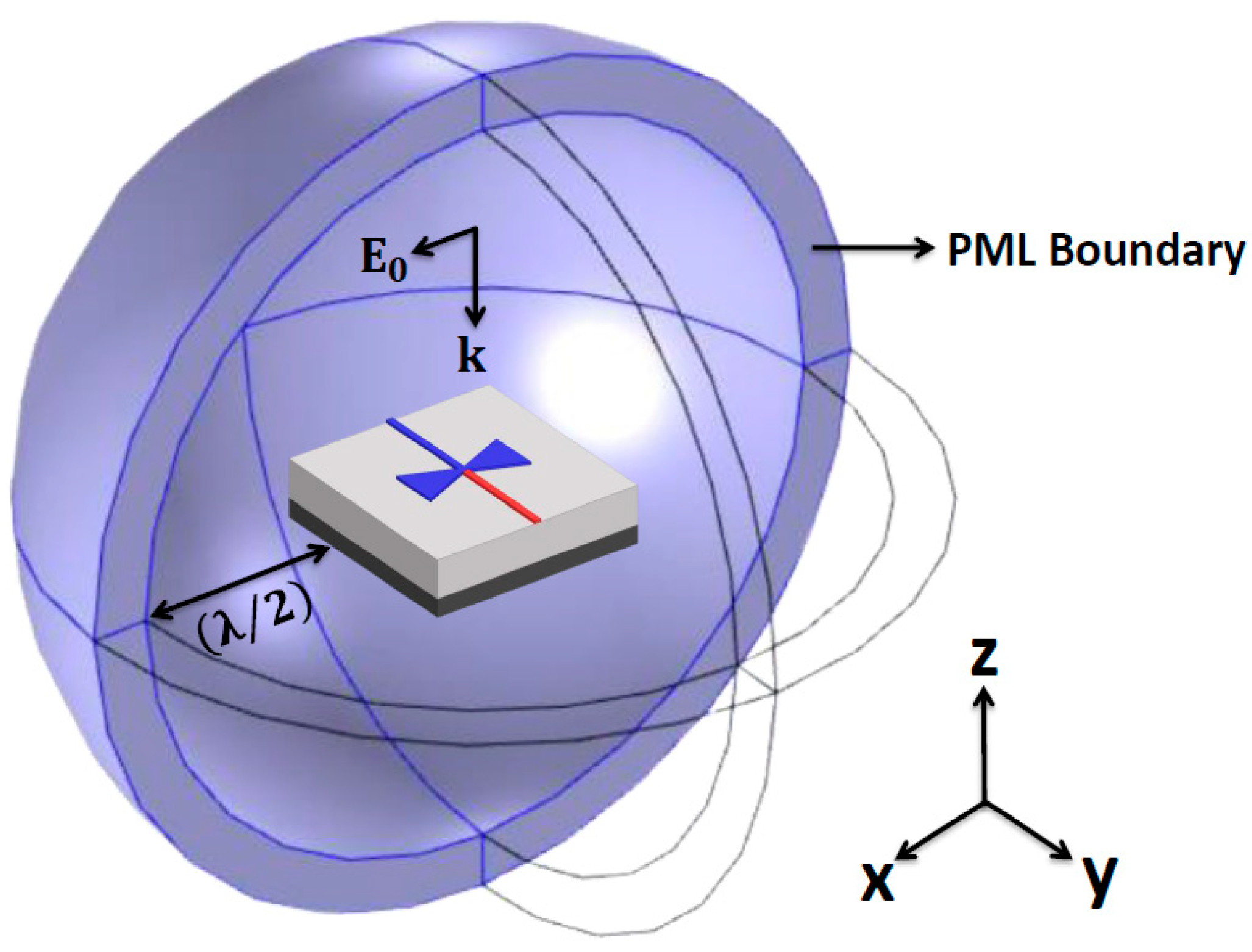

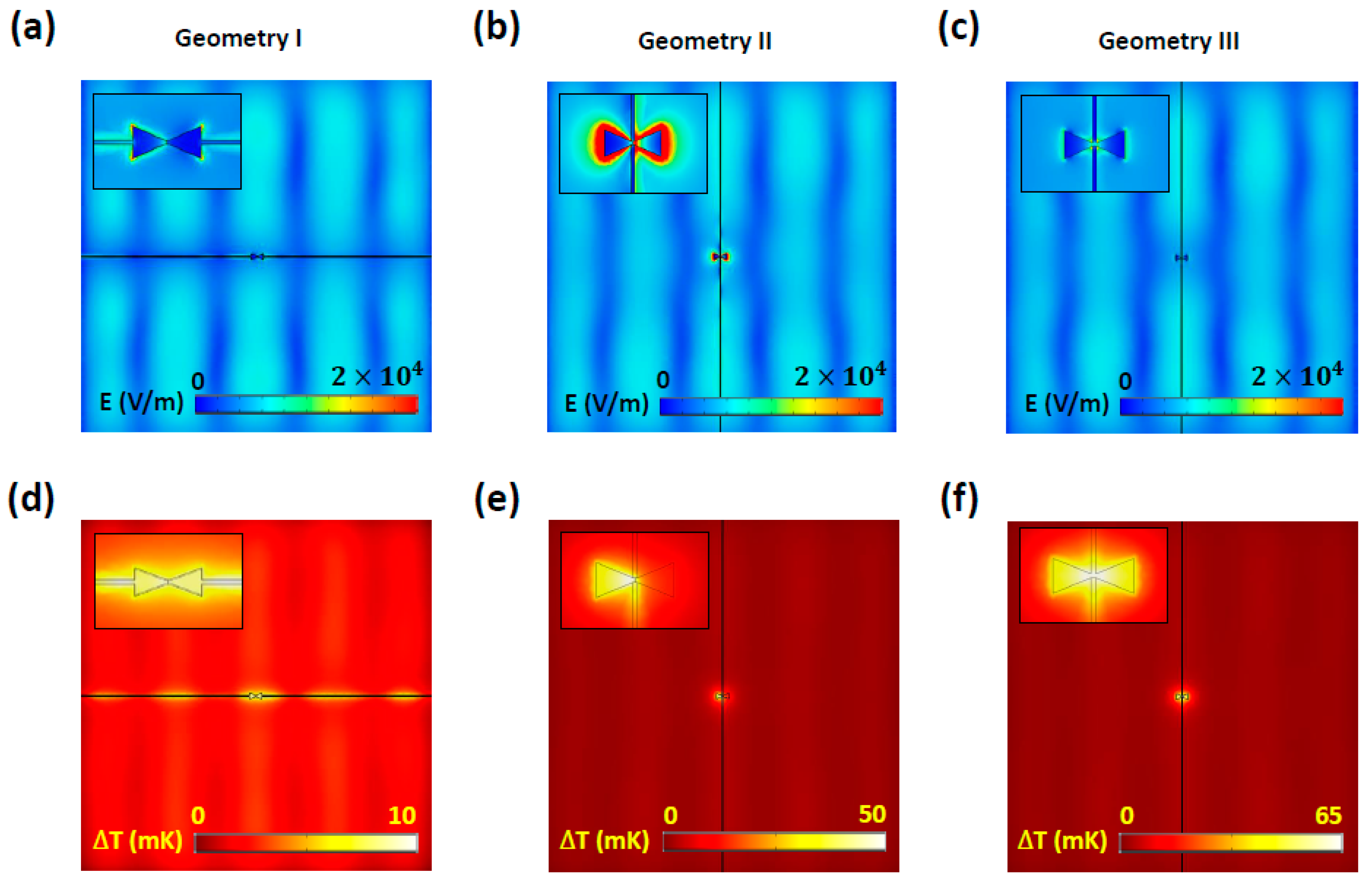

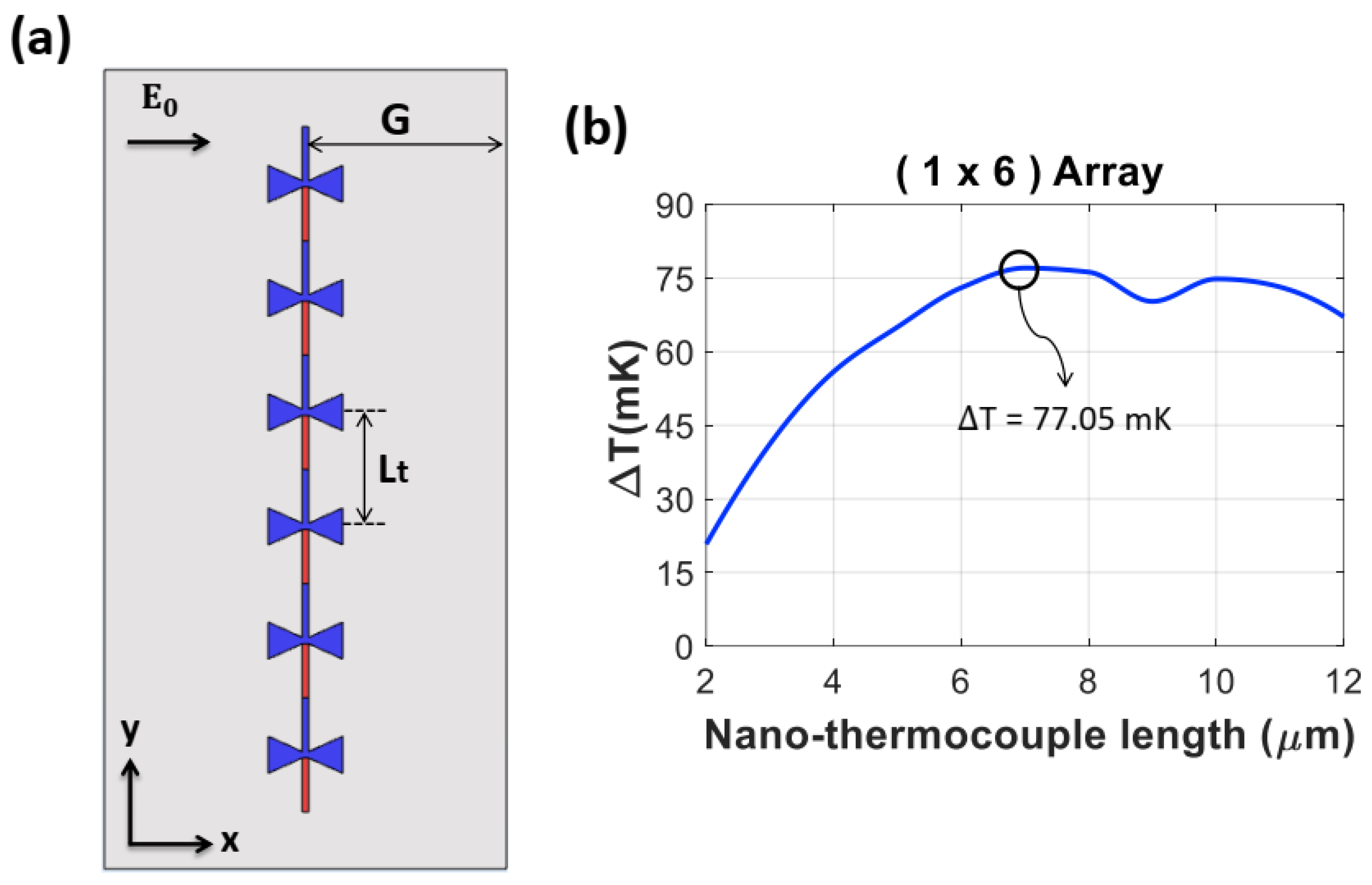


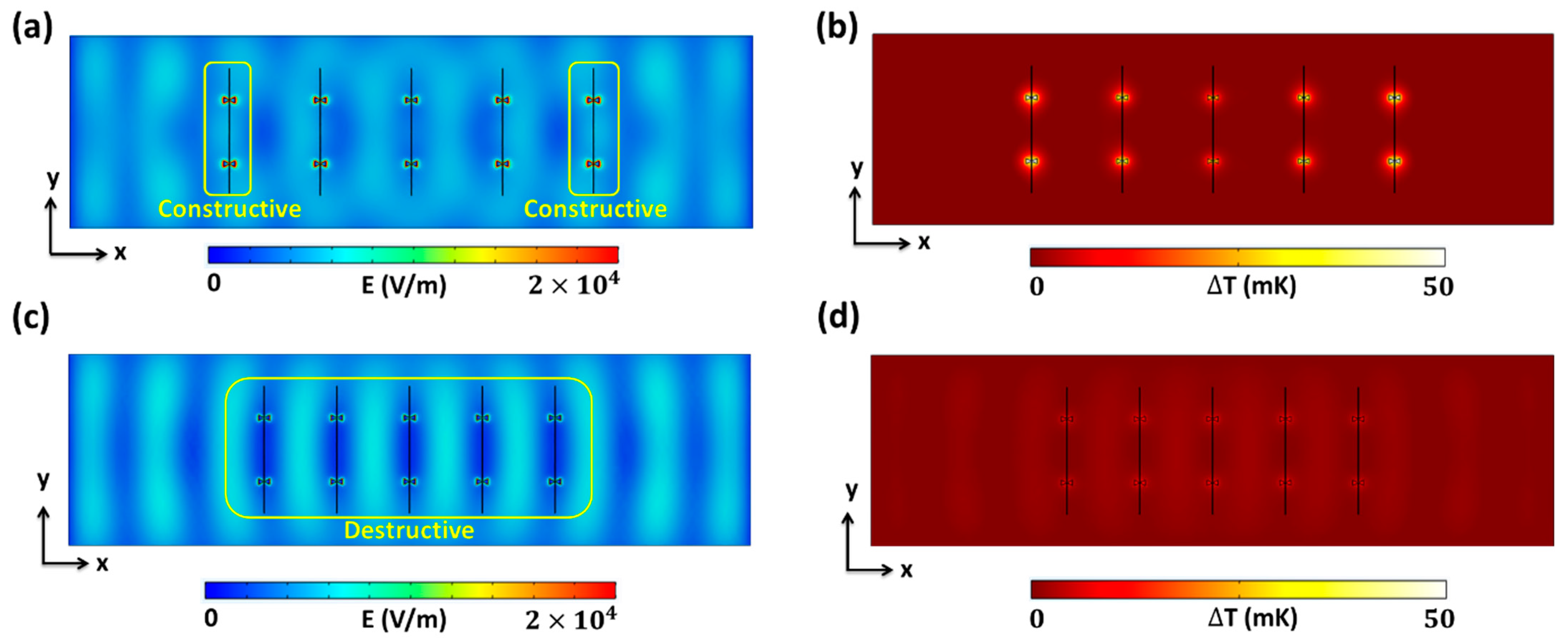

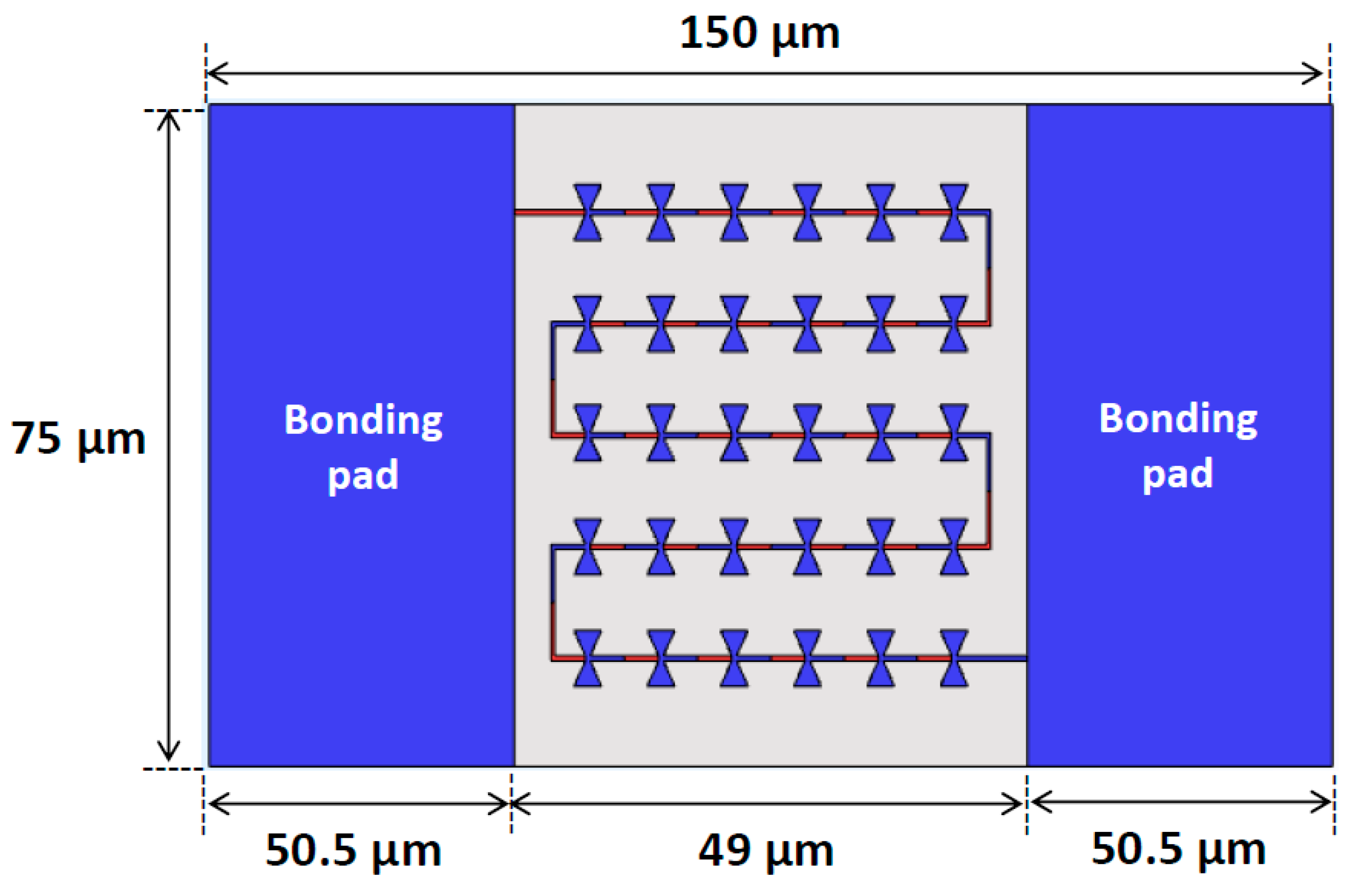
| Ref. | Antenna Topology (Material) | Thermocouple | Substrate | # of Antennas | Power Density (W/cm2) | Aperture Size (µm2) | Voc (µV) | βv (V/W) |
|---|---|---|---|---|---|---|---|---|
| [22] | Dipole (Pd) | Pd | Grounded SiO2 | 440 | 1.42 | 7.04 | 3.25 | 0.032 |
| [23] | Dipole (Pd) | Ni-Pd | Air-filled cavity | 200 | 1.42 | 2.2 | 200 | 0.64 |
| [40] | Dipole (Pd) | Ni-Pd | Air-filled cavity | 52 | 1.42 | 6 | 9.37 | 0.011 |
| [41] | Bowtie (Au) | Bi2Te3-Sb2Te3 | Air-filled cavity | 16 | 0.1 | 1.1 | 55 | 50 |
| [42] | Dipole (Au) | Bi2Te3-Ni | Air-filled cavity | 16 | 0.1 | 5.76 | 30 | 52.08 (40 THz) |
| This work | Bowtie (Ti) | Ni-Ti | Open-ended and grounded SiO2 | 30 | 1.42 | 3.67 | 40.18 | 0.77 |
Disclaimer/Publisher’s Note: The statements, opinions and data contained in all publications are solely those of the individual author(s) and contributor(s) and not of MDPI and/or the editor(s). MDPI and/or the editor(s) disclaim responsibility for any injury to people or property resulting from any ideas, methods, instructions or products referred to in the content. |
© 2024 by the authors. Licensee MDPI, Basel, Switzerland. This article is an open access article distributed under the terms and conditions of the Creative Commons Attribution (CC BY) license (https://creativecommons.org/licenses/by/4.0/).
Share and Cite
Anam, M.K.; Yudhistira, Y.; Choi, S. Optimization of Thermoelectric Nanoantenna for Massive High-Output-Voltage Arrays. Nanomaterials 2024, 14, 1159. https://doi.org/10.3390/nano14131159
Anam MK, Yudhistira Y, Choi S. Optimization of Thermoelectric Nanoantenna for Massive High-Output-Voltage Arrays. Nanomaterials. 2024; 14(13):1159. https://doi.org/10.3390/nano14131159
Chicago/Turabian StyleAnam, Mohamad Khoirul, Yudhistira Yudhistira, and Sangjo Choi. 2024. "Optimization of Thermoelectric Nanoantenna for Massive High-Output-Voltage Arrays" Nanomaterials 14, no. 13: 1159. https://doi.org/10.3390/nano14131159







